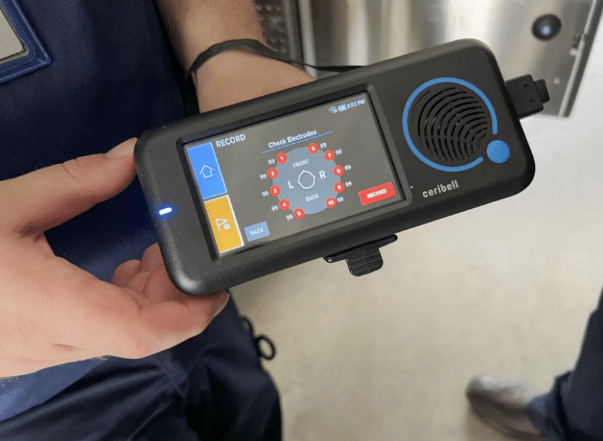Humboldt EMS Takes Care to Next Level With Portable EEG Device

With a piece of new technology, the Humboldt County Memorial Hospital Emergency Medical Service hopes to be a trail blazer in optimizing diagnosis and treatment of patients having seizures. The Ceribell is a portable rapid-response EEG device that wraps a series of sensors around the head with a headband that then connects to a computer that reads the information picked up by the sensors to determine the severity of the seizure. When a patient is having a non-convulsive seizure, it’s impossible for medics and physicians to know it’s happening or to what severity without the use of an EEG machine reading the patient's brainwaves, said Victor Bycroft, Chief Nurse Executive of HCMH. The problem is that EEG machines are large, bulky, expensive, time consuming and many hospitals don't own one. so it can take up to 12 hours to get a patient transported to a medical center equipped with an EEG machine.
A conventional EEG requires a specialized technician to attach a series of sensors that can take up to an hour to place. With Ceribell, a patient's EEG reading takes just minutes.
By being able to accurately gauge the severity of a patient's seizure, medics and physicians can provide faster and more precise treatment, rather than over-medicating or under-medicating the patient, Bycroft said.

The Ceribell device can be used on patients ages 2 and up. The company is working on developing a neonatal headband to be able to use for infants and toddlers.
HCMH received two Ceribell devices - one is used in the ER, while the EMS has the other. Both have already been in use in the few weeks since they've arrived.
Humboldt EMS is one of just 3 EMS providers in the country who are using the Ceribell, and the only one in Iowa. Nationwide, about 400 hospitals have a Ceribell device, but none are in this area.
Humboldt EMS and the hospital are part of a pilot study on the use of the Ceribell through the University of New Mexico.
"We're hoping that with the data we're collecting that we can make this the gold standard for EMS," Jordan Erie said. "I would love to see this on every EMS service across the state".
The Ceribell device is so new - it was developed in 2018 - that the State of Iowa's Bureau of Emergency Medical and Trauma Services doesn't have any guidance on its use. "We're working with the state to actually develop protocols for EMS," Erie said.
With the devices already proving their worth, Erie believes the Ceribell will be here to stay. "I do expect this to be the standard in five years."
The Ceribell may be used for more than seizures in the future, Bycroft said. The company is working on developing software so the device can be used to detect strokes, concussions and more. "This is a tool that we really need here in this rural area," he said. "This is going to be a huge benefit for our patients."
- Article written by The Messenger
- Photos by Kelby Wingert, The Messenger